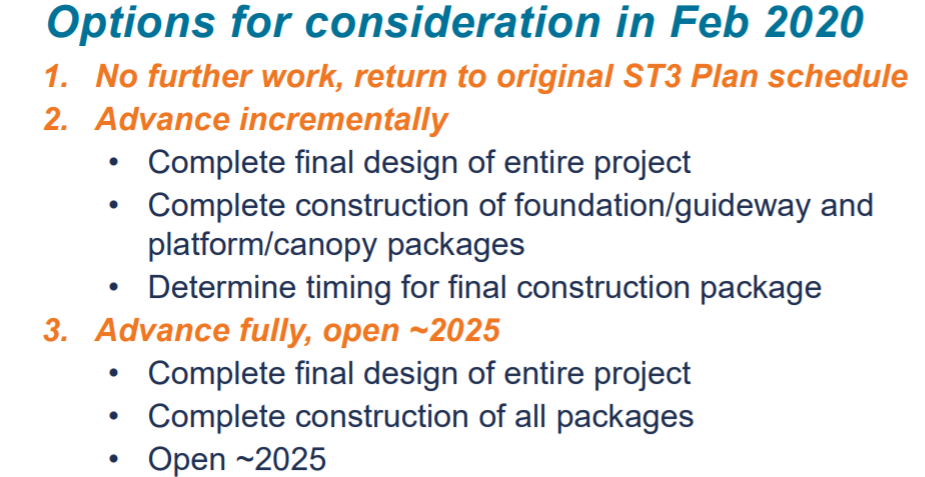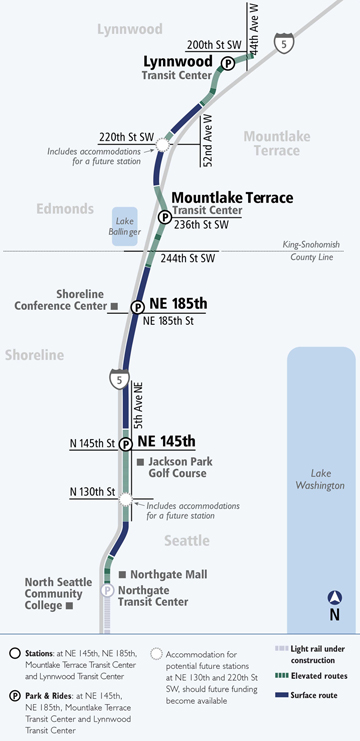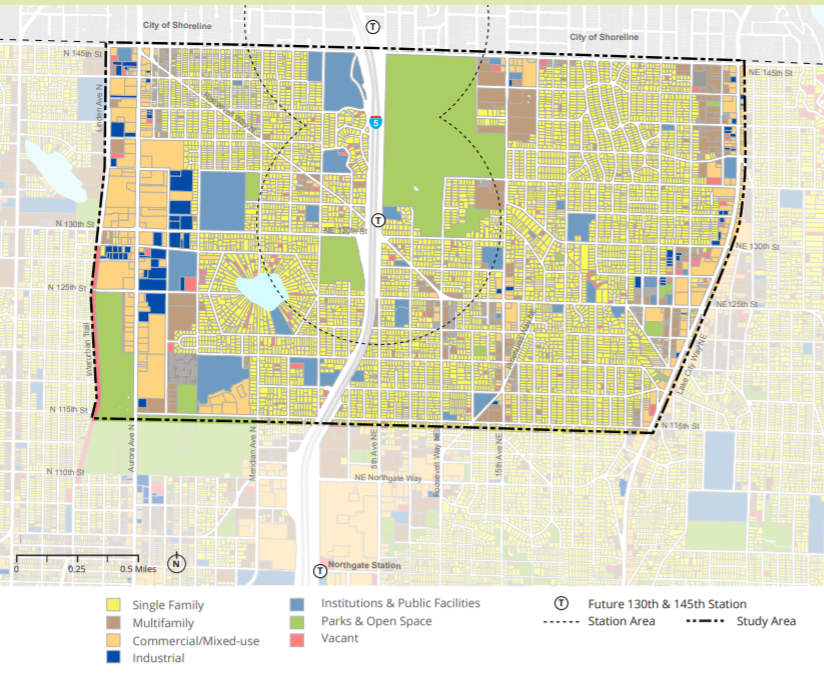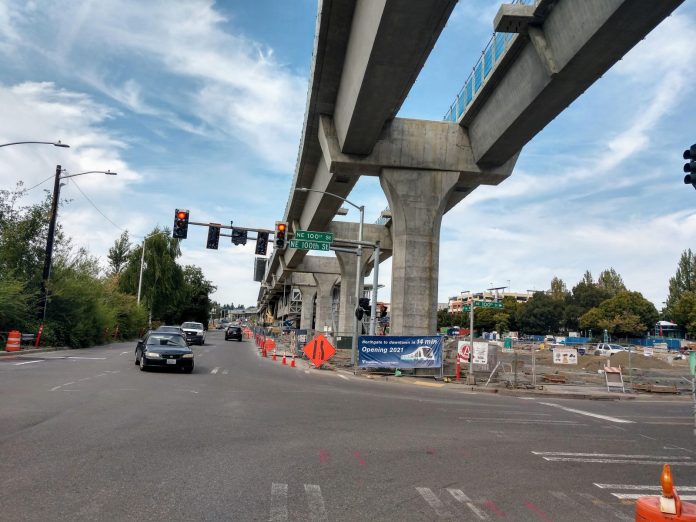
The first Sound Transit Board committee meeting of 2020 was an eventful one as staff presented three options to deliver a NE 130th Street light rail station that is being added to the Lynnwood Link extension. The station will give Seattle one more station nestled between Northgate and Shoreline South, but the question is when will the station open?
One option would deliver the station nearly concurrently with the rest of Lynnwood Link, as transit advocates have urged. Lynnwood Link will open in 2024, while 130th Station would open around 2025 in the plan presented. The other two options staff presented have the potential for later timelines.
One big fan of an early opening is Councilmember Debora Juarez, who sits on the Sound Transit Board and represents Council District 5 where the station is located. “Building this station early will save taxpayers money, decrease service disruptions, reduce carbon emissions, and get more people of out their cars,” Councilmember Juarez said. Mayor Jenny Durkan agreed, saying opening the station early is a “no-brainer” at the meeting, and the majority of the public testimony was also positive.
The Sound Transit Board of Directors is expected to make its decision next month, and that decision will be complicated by the fact that cost estimates have increased on all stations along Lynnwood Link–jumping 81% for the NE 130th Street Station. The extra $33 million isn’t a big deal in the grand scheme of things, but with suburban areas also trying to fight for upgrades and faster timelines in their jurisdictions, the board may have other ideas for the money needed to speed up NE 130th Street Station’s opening.
Speaking of, Northgate Link is still coming in under budget to the tune of $50 million, staff reported. That may present an elegant solution for Sound Transit to find the money to expedite 130th Street Station. Northgate Link is also staying on schedule, with five months of float time in case anything goes wrong–or signaling a chance it may open early.
The first option would deliver the infill station in 2031, seven years after the rest of Lynnwood Link opens. One drawback of that approach is in full display right now as light rail riders endure ten weeks of delays and disruptions due to the Connect 2020 project laying the groundwork for East Link. When Central Link first went in, Sound Transit didn’t plan for future expansion of the network, which is now an emphasis of Seattle Subway’s advocacy. Sound Transit estimates that 61,000 daily riders would be affected by 130th Street construction in 2031, making it the most disruptive of the three options.
The middle option is a hybrid “incremental” approach, partially building the station to reduce costs and disruptions when the station receives finishing touches, testing, and begins service. The timing of this option is a little uncertain. Finishing and opening the station could be expedited somewhat over the 2031 timeline, but without a definite timeline, Sound Transit indicated any time between 2025 and 2031 is possible.
If the board takes no action, the punt to 2031 option would be the default and proceed. The 2031 opening date was indicated in the original Sound Transit 3 package that was voted on and approved by voters in 2016, but the campaign to open the station sooner had already began.
While the turmoil around Initiative 976 transit cuts and whether how quickly they’ll be definitively struck down may scare the board into acting conservatively on the 130th Street decision, the reality here is the money needed is peanuts in the scope of Sound Transit finances. Even the $33 million figure sounds larger than it is due to the way Sound Transit does its accounting. And remember Sound Transit’s position is that I-976 doesn’t apply to the agency since it has secured obligated financing with car tab revenues, meaning they likely fall under a bondholder protection in the state constitution.
While building 130th Street sooner could be seen as a boon to Seattle with not much benefit to other subareas, not advancing the integrated design would mean significant delays for everyone riding Link north of Northgate when Sound Transit goes back to add in the infill station. The 61,000 daily riders threatened with travel disruptions mostly live or work in Snohomish County or Shoreline.
Rising construction costs
Sound Transit attributed the jump in estimated costs to several factors: inflation in construction costs, the hilly terrain, and upgrading the escalators, which the agency realized was a necessity due to frequent issues with the cheaper escalators it is using on existing stations. All stations along the route face similar pressure, with Lynnwood Station seeing the biggest jump in construction estimates at all. Thus, the cost increase for the NE 130 Street Station would still be within the construction estimate variance of the other stations.
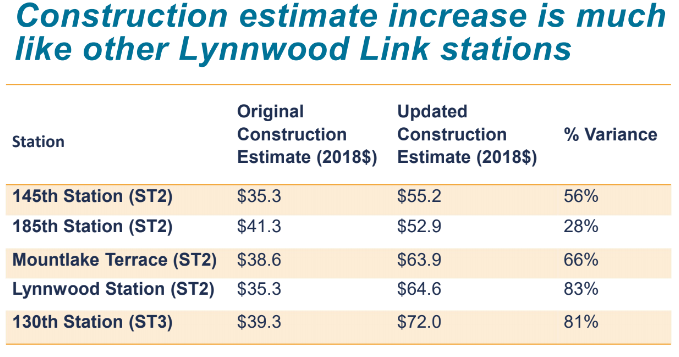
Sound Transit emphasized a number of advantages in changing the default separate structure design for 130th Station. A station structure integrated with the guideway structure in either the “advance fully” or “advance incrementally” option would be seismically safer and easier to maintain. An integrated structure rated as a better customer experience more consistent with other stations along the line. Moreover, it’d be easier to build and likely at a lower cost overall.
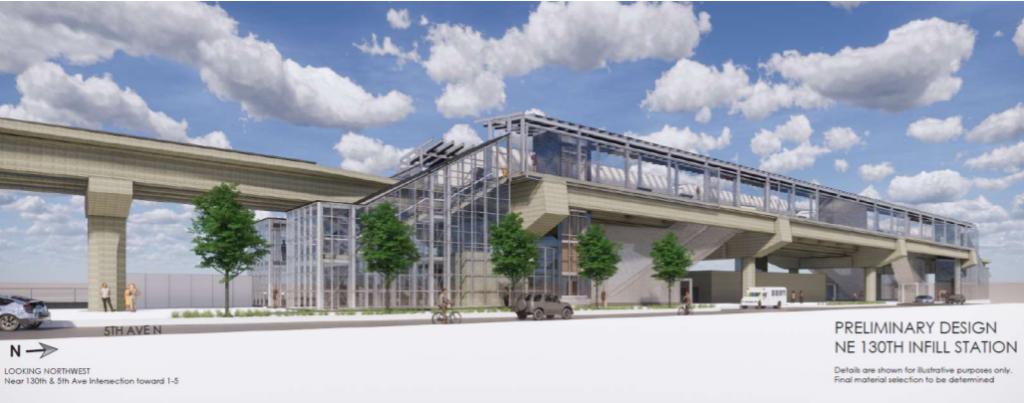
Developing the station area
The area around 130th Street Station is low-density with not much going on today. However, the City plans to rezone the station area to create a mixed-use urban neighborhood in the area, and the Seattle Office of Planning and Community Development (OPCD) is in the outreach phase. The I-5 freeway chasm represents an obstacle, limiting the walkshed to the west, where lies Haller Lake, a predominantly single-family neighborhood organized around a small lake. Pinehurst is the southeast and is again mostly single-family homes. Both areas could benefit from the development of a commercial district and apartments for residents to age in place. As it stands now, NE 130th Street does offer the best route for a bus connecting Bitter Lake and Lake City–two of North Seattle’s densest and most diverse neighborhoods–to light rail
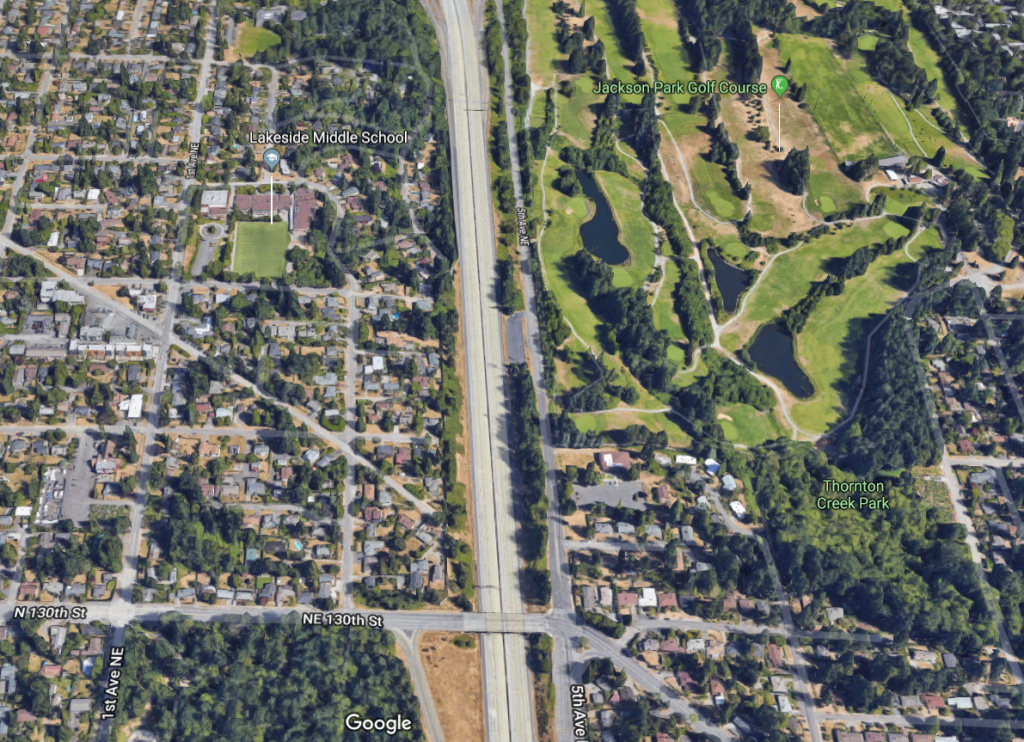
The 160-acre Jackson Park Golf Course is just to the northeast of the station and represents a big opportunity considering the course is publicly owned and already requires a subsidy to operate. Moreover, with the declining popularity of golf, the City is facing pressure to get a higher public benefit out of the considerable public land golf courses consume.
Share The Cities, a collective of housing advocates spearheaded by Laura Loe, have conducted outreach and encouraged folks to re-imagine the golf course. Their efforts have made clear that the community is interested in getting better public use out of the golf course, with better walking, rolling, and biking access through the area. Reusing golf courses became a campaign issue in the 2019 election, with the staunchest opponent–golf instructor and former Councilmember Heidi Wills–losing her bid for a District 6 seat.
OPCD’s background report found 48% of the land in the station areas is single-family zoning, 31% is parks, 7% is vacant, and just 5% is multifamily and mixed-use. That’s got to change. The presence of so much public land opens up a world of possibilities. The City could do something really creative and special. And that would help guarantee 130th Street Station is a resounding success rather than a kiss-and-ride in a sea of sprawl.
Doug Trumm is publisher of The Urbanist. An Urbanist writer since 2015, he dreams of pedestrian streets, bus lanes, and a mass-timber building spree to end our housing crisis. He graduated from the Evans School of Public Policy and Governance at the University of Washington in 2019. He lives in Seattle's Fremont neighborhood and loves to explore the city by foot and by bike.

